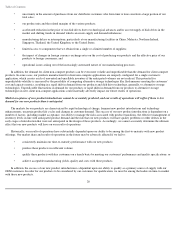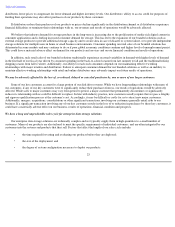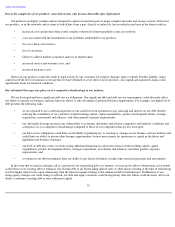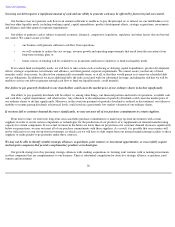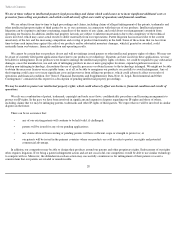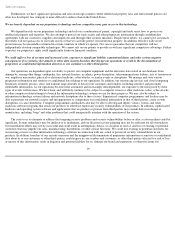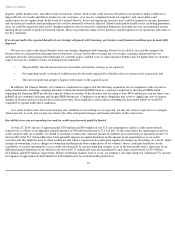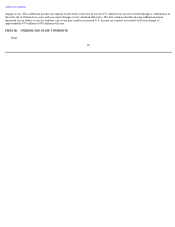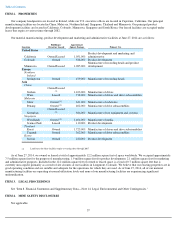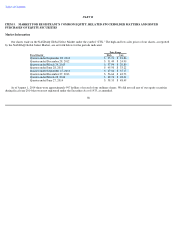Seagate 2013 Annual Report Download - page 32
Download and view the complete annual report
Please find page 32 of the 2013 Seagate annual report below. You can navigate through the pages in the report by either clicking on the pages listed below, or by using the keyword search tool below to find specific information within the annual report.
Table of Contents
Furthermore, we have significant operations and sales in foreign countries where intellectual property laws and enforcement policies are
often less developed, less stringent or more difficult to enforce than in the United States.
We are heavily dependent on our proprietary technology and our competitors may gain access to this technology.
We depend heavily on our proprietary technology and rely on a combination of patent, copyright and trade secret laws to protect our
intellectual property and expertise. We also attempt to protect our trade secrets and other proprietary information through confidentiality
agreements with our customers, suppliers and employees and through other security measures. Despite these efforts, we cannot give assurances
that others will not gain access to our trade secrets or that we can fully protect our intellectual property. In addition, effective trade secret
protection may be unavailable or limited in certain countries in which we operate. Nor can we guarantee that our competitors will not
independently develop comparable technologies. We cannot rely on our patents to provide us with any significant competitive advantage. Failure
to protect our proprietary rights could significantly harm our financial condition.
We could suffer a loss of revenue and increased costs, exposure to significant liability, reputational harm, and other serious negative
consequences if we sustain cyber-attacks or other data security breaches that disrupt our operations or result in the dissemination of
proprietary or confidential information about us or our customers or other third
-parties.
Our operations are dependent upon our ability to protect our computer equipment and the electronic data stored in our databases from
damage by, among other things, earthquake, fire, natural disasters, accidents, power disruptions, telecommunications failures, acts of terrorism or
war, employee misconduct, physical or electronic break-ins, cyber-attacks, or similar events or disruptions. We manage and store various
proprietary information and sensitive or confidential data relating to our operations. In addition, our outsourcing services and cloud computing
businesses routinely process, store, and transmit large amounts of data for our customers and vendors, including sensitive and personally
identifiable information. As our operations become more automated and increasingly interdependent, our exposure to the risks posed by these
types of events will increase. We have been, and will likely continue to be, subject to computer viruses or other malicious codes, cyber-attacks,
or other computer-related attempts to breach the information technology systems we use for these purposes. We may also be subject to
information technology system failures and network disruptions due to these factors. Experienced computer programmers and hackers may be
able to penetrate our network security and misappropriate or compromise our confidential information or that of third-parties, create system
disruptions, or cause shutdowns. Computer programmers and hackers also may be able to develop and deploy viruses, worms, and other
malicious software programs that attack our products or otherwise exploit any security vulnerabilities of our products. In addition, sophisticated
hardware and operating system software and applications that we produce or procure from third-parties may contain defects in design or
manufacture, including "bugs" and other problems that could unexpectedly interfere with the operation of the system.
The costs to us to eliminate or address the foregoing security problems and security vulnerabilities before or after a cyber-incident could be
significant. System redundancy may be ineffective or inadequate, and our disaster recovery planning may not be sufficient for all eventualities.
Our remediation efforts may not be successful and could result in interruptions, delays, or cessation of service, and loss of existing or potential
customers that may impede our sales, manufacturing, distribution, or other critical functions. We could lose existing or potential customers for
outsourcing services or other information technology solutions in connection with any actual or perceived security vulnerabilities in our
products. In addition, breaches of our security measures and the unapproved dissemination of proprietary information or sensitive or confidential
data about us or our customers or other third-parties, could expose us, our vendors and customers, or other third-parties affected to a risk of loss
or misuse of this information, result in litigation and potential liability for us, damage our brand and reputation, or otherwise harm our
29



